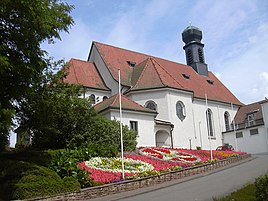Castle albums
|
Castle albums
Local community Waldfischbach-Burgalben
|
||
|---|---|---|
| Coordinates: 49 ° 16 ′ 44 " N , 7 ° 38 ′ 29" E | ||
| Height : | 270 m above sea level NHN | |
| Residents : | 1000 | |
| Incorporation : | 7th June 1969 | |
| Postal code : | 67714 | |
| Area code : | 06333 | |
|
Location of Burgalben in Rhineland-Palatinate |
||
|
New pilgrimage church Maria Rosenberg (1912)
|
||
With around a thousand inhabitants, Burgalben is the smaller district of the municipality of Waldfischbach-Burgalben in the Rhineland-Palatinate district of Südwestpfalz .
location
Burgalben is located on the western edge of the Palatinate Forest in the so-called Palatinate Woodland . The Schwarzbach flows through Burgalben . Burgalben also includes the nationally known pilgrimage site of Maria Rosenberg , the youth village Sickingen, the group of houses “Am Wallerbühl” and the Harzkaut and Moschelmühle residential areas .
history
middle Ages
The name of the place is derived from the Schwarzbach, which is also known as Burgalb in the upper reaches . The village belonged to the Lemberg office of the County of Zweibrücken-Bitsch and there to the Donsieders official school . The Muschelmühle (Moschelmühle) and the Sinnmühle belonged to Burgalben.
Modern times
Count Jakob von Zweibrücken-Bitsch (* 1510; † 1570) died in 1570 as the last male member of his family. The Lemberg office was inherited by his daughter, Ludovica Margaretha von Zweibrücken-Bitsch , who was married to the (heir) Count Philipp (V) von Hanau-Lichtenberg . Her father-in-law, Count Philipp IV. Von Hanau-Lichtenberg , gave the strict Roman Catholic Duke Karl III by immediately introducing the Lutheran creed . of Lorraine, the opportunity to intervene militarily, as the latter had suzerainty over the Bitsch rule, which was also part of the inheritance . In July 1572 Lorraine troops occupied the county. Since Philip IV was unable to cope with the overwhelming power of Lorraine, he chose the legal route. In the subsequent process before the Imperial Court of Justice, Lorraine was able to prevail with regard to the Bitsch rule, while the Lemberg office - and thus also Burgalben - was awarded to the County of Hanau-Lichtenberg .
1736 died with Count Johann Reinhard III. the last male representative of the Hanau family. Due to the marriage of his only daughter, Charlotte (* 1700; † 1726), with the Hereditary Prince Ludwig (VIII.) (* 1691; † 1768) of Hesse-Darmstadt , the county of Hanau-Lichtenberg fell there. In the course of the French Revolution , the part of the County of Hanau-Lichtenberg on the left bank of the Rhine - and with it the Office of Lemberg and Burgalben - fell to France in 1793. After the end of Napoleonic rule, Burgalben came to the Bavarian Rhine District .
Burgalben belonged to the mayor's office of Waldfischbach even before 1919. In the course of the administration reform in Rhineland-Palatinate, Burgalben was merged on June 7, 1969 with the neighboring community of Waldfischbach to form the new community of Waldfischbach-Burgalben.
politics
mayor
- Before 1919 it belonged to the mayor's office in Waldfischbach
- 1919–1920: Karl Kettering
- 1920–1923: Jakob Müller IV.
- 1923–1928: Jakob Auer
- 1928–1933: Jakob Müller IV.
- 1933–1945: Adolf Kemnitzer
- 1945–1946: Hans Müller
- 1946–1952: Otto Mangold I.
- 1952–1969: Heinrich Hufnagel
coat of arms
| Blazon : "divided by red and gold, right the goldbekrönte and -gewandete Madonna, in her left the goldbekrönte child, holding in his right hand a four-leaf bestielte silver rose, left a blue reinforced and -bezungter red lion." | |
| Justification for the coat of arms: The red lion depicted in the coat of arms indicates that it belongs to the County of Zweibrücken , the Madonna indicates the pilgrimage site of Maria Rosenberg. The red lion with its golden background was later incorporated into the coat of arms of the newly formed community of Waldfischbach-Burgalben. |
Culture
In the area of Burgalben there are a total of six monuments with the pilgrimage church Maria Rosenberg , the local evangelical church, two half-timbered houses, the former school and a former mill on the Schwarzbach a little outside .
traffic
In 1905 the place received with the Biebermühlbahn ( railway line Biebermühle (today: Pirmasens Nord ) - Waldfischbach), connection to the railway network. In 1913 the line was tied to Kaiserslautern . The Burgalben stop was abandoned after the Second World War .
literature
- Official directory and statistics of the royal Bavarian administrative district of the Palatinate . Speyer 1870.
- Friedrich Knöpp: Territorial holdings of the County of Hanau-Lichtenberg in Hesse-Darmstadt . [typewritten] Darmstadt 1962. [Available in the Hessisches Staatsarchiv Darmstadt , signature: N 282/6].
- Alfred Matt: Bailliages, prévôté et fiefs ayant fait partie de la Seigneurie de Lichtenberg, du Comté de Hanau-Lichtenberg, du Landgraviat de Hesse-Darmstadt . In: Société d'Histoire et d'Archaeologie de Saverne et Environs (Eds.): Cinquième centenaire de la création du Comté de Hanau-Lichtenberg 1480 - 1980 = Pays d'Alsace 111/112 (2, 3/1980), p 7-9.
Web links
Individual evidence
- ↑ State Statistical Office Rhineland-Palatinate (ed.): Official directory of the municipalities and parts of the municipality. Status: January 2018 [ Version 2020 is available. ] . S. 109 (PDF; 2.2 MB).
- ↑ Knöpp, p. 8; Matt, p. 9.
- ↑ Knöpp, p. 9.
- ↑ Directory of officials .
- ↑ Official municipality directory (= State Statistical Office of Rhineland-Palatinate [Hrsg.]: Statistical volumes . Volume 407 ). Bad Ems February 2016, p. 181 (PDF; 2.8 MB).




